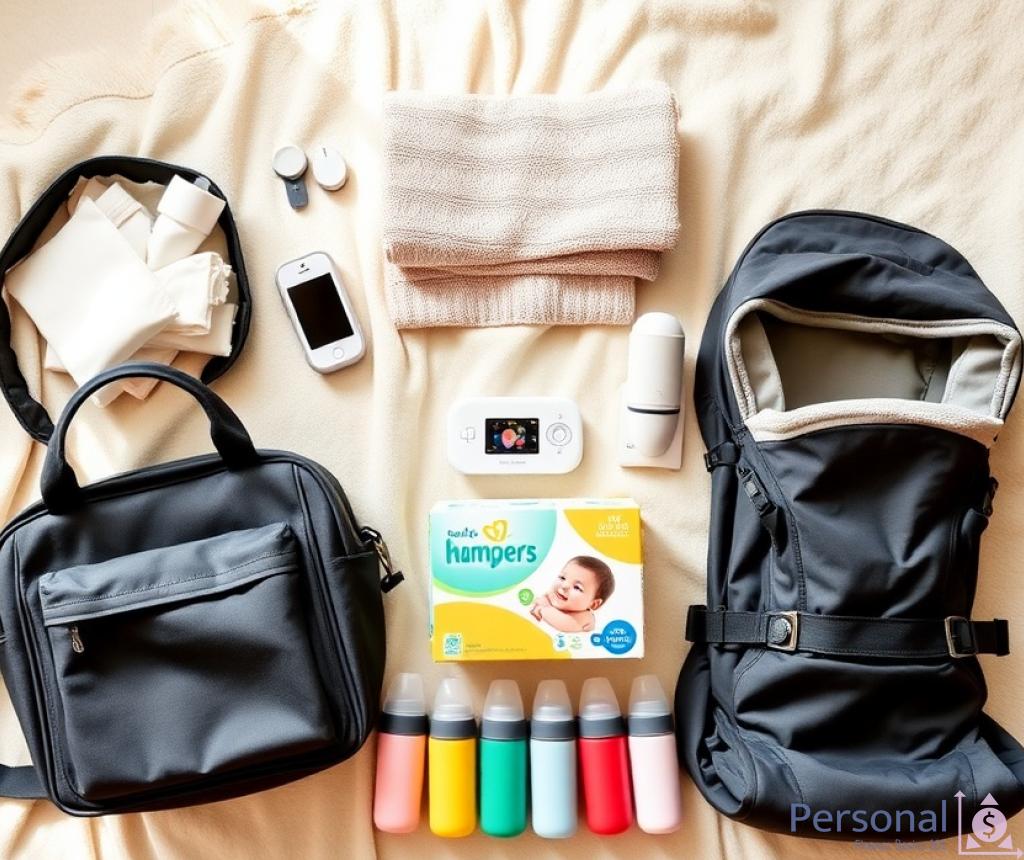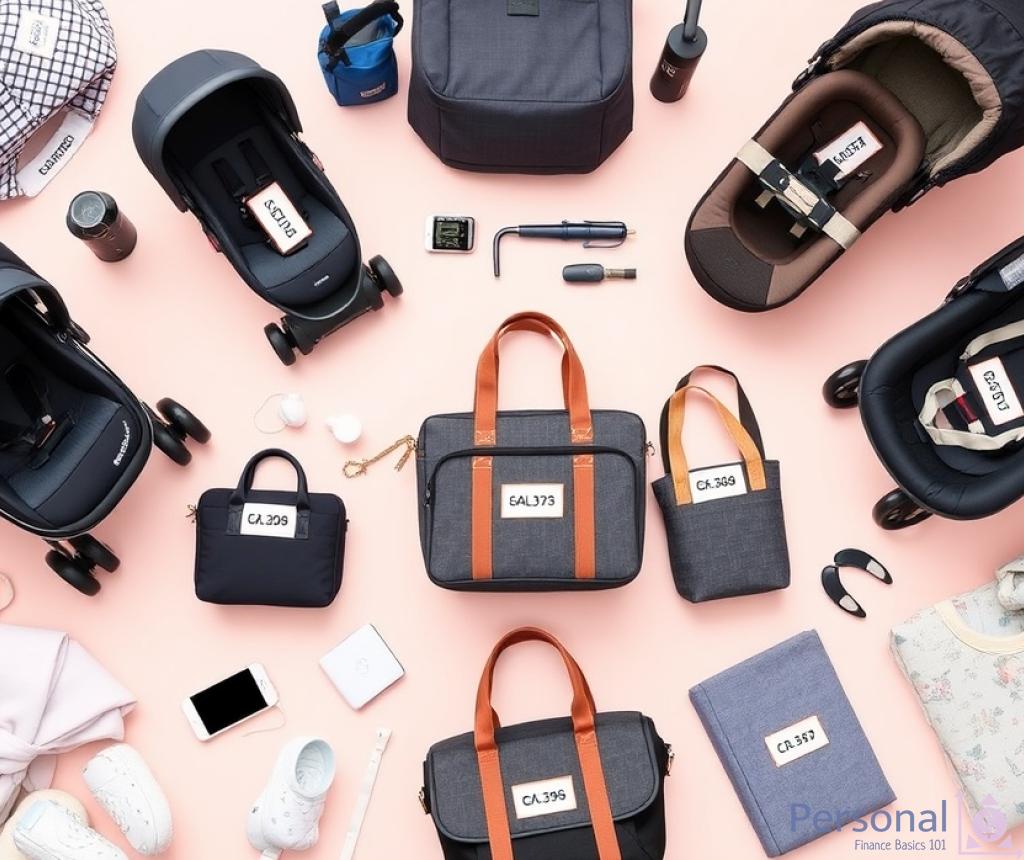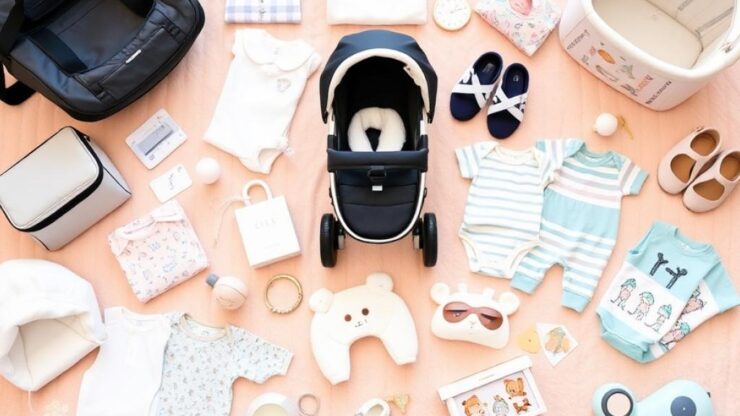Essential Baby Gear: A Comprehensive List

Understanding the Basics of Baby Gear
Bringing a new baby into the world is a joyous occasion, but it also comes with its fair share of responsibilities, particularly in terms of budgeting. As you prepare for your little one, distinguishing between essential baby gear and what might be considered nice-to-haves is crucial. This comprehensive list aims to simplify the decision-making process, ensuring that you invest wisely in items that will genuinely enhance your parenting experience.
The Must-Have Essentials
When it comes to baby gear, certain items are indispensable for new parents. These essentials are not just about comfort; they are about safety, convenience, and meeting your baby’s basic needs. Investing in these items will lay a solid foundation for your journey into parenthood.
- Crib: A safe sleeping environment is paramount. Look for cribs that meet safety standards and are sturdy.
- Car Seat: A reliable car seat is a legal requirement and a crucial safety item for transporting your baby.
- Stroller: Choose a stroller that fits your lifestyle, whether it’s for jogging or navigating city sidewalks.
- Diapers: Stock up on both disposable and cloth options, as they are essential for your baby’s hygiene.
- Baby Monitor: This allows you to keep an eye (or ear) on your baby while they sleep, providing peace of mind.
Nice-to-Have Items That Can Enhance Your Experience
While the essentials are necessary for survival, there are several items that can enhance the experience of parenting. These items can provide extra convenience, comfort, or enjoyment, but they can also contribute to your overall budget, so consider your personal needs before purchasing.
- Baby Carrier: A baby carrier can be a valuable tool for hands-free carrying, promoting bonding while allowing you to multitask.
- Changing Table: Although a changing pad on any flat surface will suffice, a dedicated changing table can make diaper changes more efficient.
- Breast Pump: For breastfeeding moms, a good breast pump can facilitate feeding flexibility and support milk supply.
- Sound Machine: A soothing sound machine can help your baby sleep better, especially if they are sensitive to noise.
- Play Gym: Provides entertainment and stimulation for your baby, aiding their development through play.
Comparative Overview of Must-Haves vs. Nice-to-Haves
To further clarify your choices, here’s a comparative overview that categorizes must-have essentials against nice-to-have items. This table can help you visualize where to allocate your budget effectively.
| Category | Essential Items | Nice-to-Have Items |
|---|---|---|
| Safety | Crib, Car Seat | – |
| Daily Care | Diapers, Baby Monitor | Changing Table |
| Travel | Stroller | Baby Carrier |
| Feeding | – | Breast Pump |
| Comfort | – | Sound Machine, Play Gym |
Evaluating Cost vs. Value: What You Really Need

As new parents embark on the journey of welcoming a baby, the excitement often intertwines with the daunting task of budgeting. The multitude of products available can overwhelm even the most seasoned shoppers. Thus, understanding the cost versus value of each item becomes imperative in making informed purchasing decisions. This section will delve into how to assess whether an item is worth the investment based on its utility and longevity.
Understanding the Financial Impact
When analyzing baby gear, it’s essential to reflect on the overall financial impact. Each item you consider should not only serve your immediate needs but also offer long-term value. For example, while a high-end stroller may come with a hefty price tag, it could save you money in the long run if it can convert to a toddler seat or withstand the test of time through multiple children. Therefore, evaluating how often you will use an item and its potential to adapt to your changing needs will guide you in distinguishing between necessities and luxuries.
Key Considerations for Smart Spending
To ensure that your expenditures align with your priorities, consider the following factors:
- Frequency of Use: How often will you use this item? Daily essentials warrant a more significant investment.
- Durability: Is the product built to last? Items that can endure wear and tear will provide better value over time.
- Multi-functionality: Does the product serve multiple purposes? Versatile items can often reduce the need for additional purchases.
- Brand Reliability: Is the brand known for producing high-quality products? Investing in reputable brands can lead to better resale value and satisfaction.
By weighing these considerations, parents can streamline their purchasing decisions, focusing on gear that genuinely contributes to their family life.
Making the Right Choices
Ultimately, the decision-making process will vary based on personal circumstances, including lifestyle, budget, and preferences. It is crucial to remember that while some items may seem enticing, they may not provide the necessary returns in value. By prioritizing essentials, such as safety items and daily care necessities, while being selective about nice-to-haves, parents can create a well-rounded, functional collection of baby gear that enhances their parenting journey without leading to financial strain.
Budgeting Strategies for First-Time Parents
Bringing a new life into the world is both exhilarating and challenging, especially in terms of financial planning. First-time parents often find themselves navigating a maze of baby gear options, all while trying to stick to a budget. Developing a solid budgeting strategy is essential to ensure that you invest wisely in items that will support your family’s needs without overspending. This section will outline effective strategies to manage your baby gear budget with confidence.
Setting a Realistic Budget
Before diving into the world of baby gear, it’s crucial to establish a budget that aligns with your financial situation. Here are some actionable steps to create a realistic budget:
- Assess Your Finances: Take a close look at your income, expenses, and savings to determine how much you can allocate for baby gear.
- Prioritize Essentials: Focus first on must-have items that ensure safety and comfort for your baby. Create a separate list for nice-to-haves that can be acquired later.
- Plan for Ongoing Costs: Remember to consider recurring expenses such as diapers, formula, and clothing. These will impact your budget in the long term.
Research and Comparison Shopping
Once you have a budget in place, the next step is to research and compare prices. This can save you significant amounts of money. Here are some tips to effectively shop:
- Online Research: Utilize online resources to compare prices across different retailers, and check for sales or promotions.
- Read Reviews: Look at customer reviews and ratings to gauge the quality and reliability of products before making a purchase.
- Consider Second-Hand Options: Explore second-hand marketplaces for gently used items, which can be a great way to save money without compromising on quality.
Making Use of Registries and Discounts
Many retailers offer baby registries that can benefit first-time parents. These registries allow you to compile a list of desired items while also providing friends and family with gift ideas. Additionally, consider the following:
- Utilize Discounts: Look for first-time buyer discounts or coupons that can help you save on your purchases.
- Join Loyalty Programs: Many baby gear brands and retailers offer loyalty programs that provide rewards and discounts on future purchases.
- Seek Community Support: Engage with local parenting groups or online forums for advice and recommendations on budgeting strategies and gear.
Identifying Nice-to-Have Items: When to Splurge
As you navigate the exciting yet overwhelming world of baby gear, it’s essential to discern which items are truly necessary and which can be classified as nice-to-haves. Understanding this distinction can lead to more informed purchasing decisions and ultimately save you money. This segment will explore how to identify those alluring extras that can enhance your parenting experience while also addressing when it’s prudent to invest a little more for added convenience and comfort.
Evaluating the Value of Nice-to-Have Items
Nice-to-have baby gear can often be tempting, with their promise of making life easier or more enjoyable. However, before splurging on these items, consider their potential value. Ask yourself how often you will use the item and whether it offers significant benefits over its less luxurious counterparts. For instance, while high-end baby carriers may come with features like extra cushioning and stylish designs, a more basic model can still provide the essential function of hands-free carrying. It’s about finding the right balance between quality and necessity.
Timing Your Splurge: When to Invest More
Deciding when to splurge on baby gear can be a nuanced process. Certain factors can guide your decision, such as your lifestyle, family dynamics, and future plans. If you foresee welcoming more children, investing in durable, multi-functional items may be worthwhile. For example, a versatile stroller that can adapt from infant to toddler can serve your family for years, justifying the higher price tag. Moreover, if an item enhances your comfort or significantly reduces stress during daily routines, it may be worth considering as a necessity rather than a luxury.
Another critical aspect is to assess the potential for resale value. High-quality baby gear often retains its value well, making it easier to recoup some of your investment when the time comes to pass it on. This can be particularly true for brand-name items that are known for their durability and appeal in the second-hand market.
Making Informed Choices: The Power of Research
Before committing to a purchase, thorough research is your ally. Read product reviews, compare features, and explore community feedback to gauge whether the extra cost is justified. Engaging with parenting forums can shed light on the experiences of others, allowing you to weigh the pros and cons effectively. Don’t forget to check for seasonal sales or discounts that can make those nice-to-have items more financially accessible.
Ultimately, the goal is to create a well-rounded collection of baby gear that meets your family’s needs without overstretching your budget. By understanding when to splurge on nice-to-haves, you can enhance your parenting journey, ensuring that every investment contributes positively to your experience as a new parent.
Sustainable Choices: Budgeting for Eco-Friendly Gear
As the demand for environmentally responsible products continues to rise, new parents are increasingly considering sustainable choices when budgeting for baby gear. Opting for eco-friendly products not only benefits the planet but can also provide long-term savings and health benefits for your growing family. Understanding how to integrate these considerations into your budget can help you make informed decisions that align with both your financial and ethical values.
Understanding Eco-Friendly Baby Gear
Eco-friendly baby gear encompasses a range of products made from sustainable materials, designed to minimize environmental impact while ensuring safety and comfort for your child. From organic cotton clothing to biodegradable diapers, the options are vast. The first step in budgeting for eco-friendly gear is to identify the types of products that suit your lifestyle while maintaining a commitment to sustainability. Consider whether you prefer items that are reusable, recyclable, or made from renewable resources.
Cost vs. Longevity: Evaluating Eco-Friendly Options
When assessing the financial implications of eco-friendly baby gear, it is crucial to consider the longevity and durability of these products. While the initial price tag on organic or sustainably produced items may be higher, their quality often translates to prolonged use. For instance, high-quality cloth diapers can be reused for multiple children, significantly reducing waste and costs over time. As you evaluate your budget, keep in mind the potential for these items to offer greater value in the long run.
Strategies for Integrating Sustainable Choices into Your Budget
To effectively incorporate eco-friendly baby gear into your financial plan, consider the following strategies:
- Research Sustainable Brands: Seek out manufacturers known for their commitment to sustainability, as they often produce high-quality, eco-friendly products.
- Prioritize Essential Eco-Friendly Items: Focus on the must-have items that are available in eco-friendly versions, such as cribs made from sustainably sourced wood or organic baby clothing.
- Utilize Second-Hand Markets: Explore thrift stores, online marketplaces, and parenting groups for gently used eco-friendly gear, allowing you to save money while reducing waste.
- Join Parenting Co-ops: Consider co-op programs where parents share or exchange baby gear, making eco-friendly options more accessible and affordable.
By adopting these strategies, parents can create a balanced budget that reflects their commitment to sustainable living while ensuring they have the necessary gear for their newborn. Ultimately, making thoughtful, eco-conscious choices can enhance your parenting journey, connecting your family with the values of responsibility and care for the environment.
Disclaimer
This article has been created or edited with the support of artificial intelligence and is for informational purposes only. The information provided should not be considered investment advice. Please seek the support of a professional advisor before making any investment decisions.






